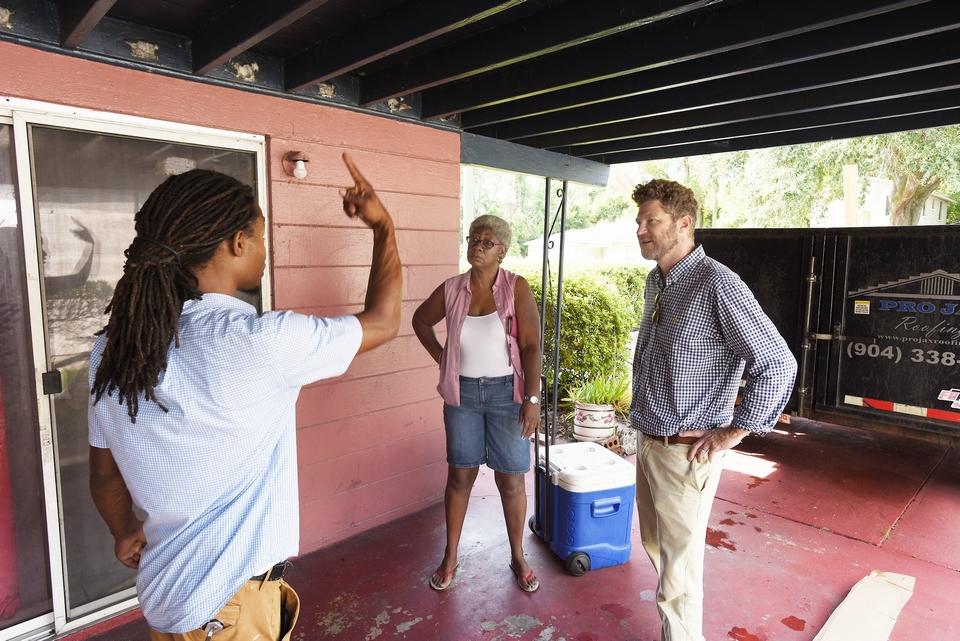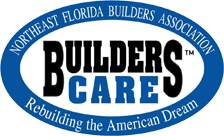When a Builders Care construction team arrived at Lequita Ward’s West 13th Street home last week, she was jubilant.
They were there to replace her roof, which was first damaged by downed pecan tree limbs during Hurricane Matthew in 2016 and again by Irma in 2017. She had no homeowners insurance and, as a senior living on a fixed income, could not afford to pay for the needed repairs. The damage was not severe enough to qualify for federal emergency funding.
A series of blue tarps to cover up the roof holes came and went, then termites showed up. Finally, Tuesday the cavalry appeared in the form of Builders Care, the Northeast Florida Builders Association’s charitable arm.
“Praise God,” she said. “Thank the Lord. … They’ve been a big blessing.”
Thousands of Jacksonville-area homes collectively sustained millions of dollars in flood damage during Irma. The Federal Emergency Management Agency registered about 118,000 damage claims from Irma in Duval and Nassau counties, compared to 3,500 for Hurricane Matthew in 2016. Homeowners who had insurance or qualified for federal assistance have gotten needed repairs and moved on with their lives. But Ward and many others, mostly the uninsured or underinsured poor and elderly, were left waiting for help.
Coordinating the cavalry to come to the rescue is the Northeast Florida Long Term Recovery Organization, a collaborative network of about 30 governmental, business, faith-based and nonprofit organizations. Organized in December 2018, the group’s executive committee meets monthly to coordinate the various assistance programs that are still available, including the American Red Cross and the First Coast Relief Fund.
Even now, an estimated 1,000 people in Duval County alone still need repairs, said board chairman Michael Boylan, recently elected to the Jacksonville City Council.
“It’s a journey,” he said. “We are the last bastion … to do the kind of work we do.”
Homeowners can also seek help through Rebuild Florida, a program of the Florida Department of Economic Opportunity that uses federal funds to repair and replace homes damaged by Irma. But the program has specific eligibility requirements some poor people cannot overcome — one family was rejected because of a $300 overdue property tax bill — and results can be slow because of its bureaucratic layers, Boylan said.
The local organization is seeking community and corporate financial support to continue its “last bastion” status.
“While progress has been made, our partners have exhausted the majority of their funding, and future funding prospects remain limited,” according to information sent to prospective donors. “In most instances, the cases … are for survivors that may not meet the criteria or priority eligibility for public assistance [through Rebuild Florida]. They all represent vulnerable populations whose circumstances prevent them from recovering without assistance.”
According to an earlier community needs assessment, 39 percent of them are elderly, 26 percent disabled, 17 percent single parents, 13 have medical problems and 10 percent are veterans. The local priority cases are low-income households with residents over 60 years of age or people with disabilities.
In 2018 Endeavors, the disaster case management organization working with the local group, closed 115 cases, with 92 households receiving rebuild or repair assistance totaling $282,762. As of June 7, there are about 181 active cases. Also, about 260 households that were destroyed or sustained major property damage received financial assistance from coalition member American Red Cross, with about 900 still eligible for funds.
Endeavors performs home damage assessments, and its federally-funded case managers work with construction managers — Builders Care and, as of 2019, Community Development Corporations — to make repair estimates for the group to consider. If funding is awarded, the construction managers arrange licensed and insured contractors and report on results.
In 2018 and 2019, Builders Care alone has repaired 133 roofs, replaced 19 roofs and done 21 interior rebuilds, using almost 10,000 volunteer hours and funds from Endeavors and multiple nonprofits including Catholic Charities, HabiJax, Cooperative Baptist Fellowship, Presbyterian Social Ministries, United Way of Northeast Florida and Yellow House Art, said Executive Director Justin Brown.
But he knows there are many more roofs and interiors still to be fixed.
“A lot of people are living under blue tarps. They don’t even know what [assistance] is available,” he said.
Homeowners are joyful and grateful when his teams arrive.
“But when you first tell them they’re going to get help is almost as good. You start to see hope in their eyes,” Brown said. “Most of them had lost hope that it was ever going to be fixed.”
Bishop E.M. Johnson is CEO of the Grace and Truth Community Development Corp. off Norwood Avenue, another of the local group’s construction managers. The CDC has several projects underway, most of which involve roof repairs or water-damaged flooring, he said. In some cases, the water damage led to mold.
“They’ve been living in a health hazard,” he said.
The residents and the surrounding community are grateful for the attention, he said.
Boylan said the coalition hopes to help a total of 100 people in 2019, with an average repair or rebuild cost of $15,000. The Irma response likely will take three years, Boylan said, but having an established coalition will benefit Northeast Florida through many storm seasons to come.
“People were distraught … that they were not going to get help and they had no recourse. We have been working to overcome that,” he said.
“We all have our role and my role was to build the process,” Boylan said. “We’re beginning to see the results.”
Beth Reese Cravey: (904) 359-4109


